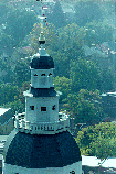
Construction of original section of the State House: 1772-1779
Architect of original State House: Joseph Horatio Anderson
Cornerstone of original State House: laid by Governor Robert Eden, March 28, 1772
Roof replacement and construction of dome by Joseph Clark, Architect: Begun 1785
Construction of present addition to State House (replacing annexes built in 1858 and 1886): 1902-1905
Architects of present addition to State House: Baldwin and Pennington of Baltimore
Height:
Served as U.S. capitol from November 1783 - August 1784 when Continental Congress met in Old Senate Chamber
Original section: Two storeys
Present addition: Three storeys
Height, from base to weather vane: 121'
Diameter at base: 40'
Construction begun: 1785
Possible model for design of the dome: Schlossturm, the dome of the free-standing tower next to the palace of Karl-Wilhelm, Markgraf of Baden, in Karlsruhe, Germany
Size: 5' tall, 3'8" in diameter; including pedestal: 9'9" tall
Material: Original cypress from ca. 1785-1788, covered with copper panels
Pedestal covered with sheet lead, probably from 1837
Original colors (from Charles Willson Peale drawing):
Replacement of the Acorn, September 1996: During restoration work on the State House dome, it was discovered that the 208 year-old acorn had become rotten because of water seepage. As it too damaged to be repaired, it was decided to replace it by having 32 craftspeople from around the state make "slices" that would be used to assemble a new acorn. The new acorn was then clad in copper and gilded and painted according to the original drawings of Charles Willson Peale.
The gilding work was done by Bill Adair of Gold Leaf Studios in Washington, D.C. Mr. Adair wrote an article for the Society of Gilders Newsletter about the work that he did on the acorn.
Size: 28' tall; 2.5" square at maximum thickness
Material: Original wrought iron
History: A prime example of lightning rod designed according to the theories of Benjamin Franklin who argued that the most effective protection from lightning was a pointed rod, preferably grounded into a deep well.
The acorn has been replaced by a new one constructed of sections made by 31 Maryland craftspeople from specification supplied by the Department of General Services. The new acorn is made of cypress wood, as was the original. The original lightning rod has been left in place and a metal sleeve placed around it for protection.
In 1997, the State House Trust and the Department of General Services were awarded the Calvert Prize by the Maryland Historical Trust for their roles in the restoration and preservation of the State House dome.
Work supervised by:
Exhibit on State House Restoration prepared by the Exhibit Services Program, Jefferson Patterson Park and Museum, Maryland Historical Trust
Return to Maryland State House Homepage
© Copyright April 13, 2006 Maryland State Archives